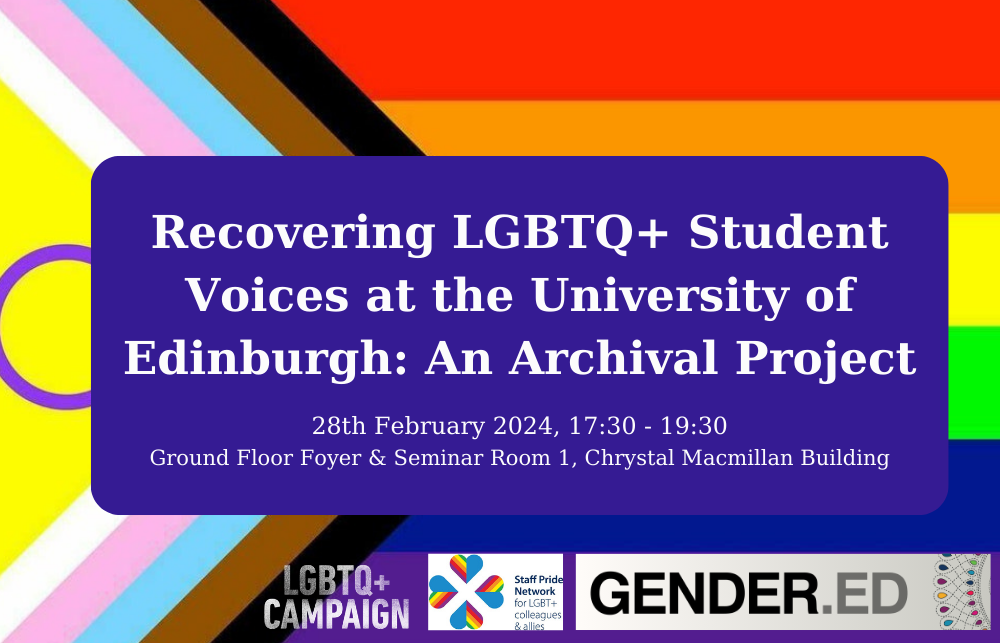Recovering LGBTQ+ Student Voices at the University of Edinburgh: An Archival Project

On 28 February, we hosted a reception and roundtable discussion to launch a new archival project by the LGBTQ+ Liberation Campaign and the Centre for Research Collections (CRC). The project seeks to uncover LGBTQ+ voices in the University’s recent history (1968-present). The roundtable was chaired by Dr Niamh Moore, Senior Lecturer in Sociology (specialising in queer theory and archival methods) and included the following speakers: Rachel Hosker, University Archivist and Research Collections Manager; Dr James Bell, Lecturer in Contemporary Art Theory (specialising in queer and trans art); Professor Sharon Cowan, Professor of Feminist and Queer Legal Studies; Ash Scholz, EUSA LGBTQ+ Liberation Officer.
The event began with a reception allowing people to meet, mingle, and enjoy a presentation put together by the LGBTQ+ Campaign and the CRC on their project. Slides with images taken from the archives showed the journey of queer activism on campus. Snippets of the Student Newspaper (still active today) showed activist Derek Ogg responding to homophobic university professors and organising the first International Gay Conference. The presentation highlighted the fantastic efforts the project is making in using the archives to bring these histories to life. Radhika Govinda, GENDER.ED Director and Ash Scholz gave short speeches to welcome guests and introduce the project.
To open the roundtable, Niamh began by asking the speakers to talk about their work and what ‘queering the archives’ means to them. Ash emphasised the importance of showing that queerness is not a new phenomenon, not an internet trend. Queer people, they remind us, have always existed at the University, and the project seeks to prove this and to show that the current waves of queer activism around campus are not new. Rachel spoke about how archive work and uncovering stories often involves following trails of breadcrumbs; there’s no clear direction, and it can be tricky to know where to start. Having met with alumni who were part of queer activism on the campus in the 70s, Rachel also highlights how archives bring our own stories back to us. James then talked of his work uncovering queer activism at Edinburgh College of Art (ECA) and, in particular, the queer student magazine Wee Red Herring. For James, the artistry of the magazine and seeing the range of events held by students at the time has brought a history of queerness at ECA to life. Sharon spoke about queering the archives projects in the Museum sector more generally and emphasised the importance of including trans narratives in our understanding of history.
Niamh then opened to questions from the audience. The first question related to the process of archiving; how do things become part of the collection? Rachel responded by telling the room that the University had only had an archivist since 1990 (a fact that still surprises me as I write it down!) and that although the archives have been working hard to recuperate records and add to the collections since then, there is plenty of work still to be done. Pointing out that the archives have often been a privileged space, Rachel reminds us that looking at who has been excluded from archive records can be as telling as who has been included. Over the 19th century, the student voice came to the fore with the inclusion of women at the University and as a result of colonial practices. These changes can be seen in the archives in terms of what was generated by students at the time as well as what has been collected. With one of the oldest student newspapers in the world, recording student voices has always been important but, Rachel stressed, we need to remain proactive in efforts to preserve these histories and record the present.
Responding to a question about how existing archives draw in more material, James highlights how much of the history of LGBTQ+ activism has been documented by the community and activists themselves. Creating these archives and returning to them is often borne of a desire for queers to find other queers; to build community. James gave examples of the Lothian Health Services Archive and the Glasgow Women’s Library. The latter received bags of records left on their doorstep as queer organisations closed down.
Many of the questions posed to the panel related to how archives may help us address current challenges. The panellists point out that the university has seen some ground-breaking activism throughout the decades and that the archives can show us the solidarity students shared with activism in their wider community whilst, as James points out, firmly becoming established as a social group in their own right. Ash speaks about how the archives have shown them that progression isn’t always linear, but that through the effort of students, activism always springs back up. The gay society, for example, had to dissolve due to harassment but then reappeared a few years later. Sharon highlights that the current interest in archives has probably sprung from a sense of disheartenment at the way the world is right now. Rachel adds that this is why we people want to see themselves in the archives, to see that other people have felt the same.
I felt that everyone left the event feeling inspired by the power archives have to help us make sense of our experiences. There is something powerful in knowing that you are not alone in activism and that there are generations of people behind you supporting your efforts to make the world a better place.
Author Bio
Amy Life is a fourth-year French and Philosophy student and an Undergraduate Communications Intern for GENDER.ED. She has previously been the president of Edinburgh University’s Feminist Society and is one of the founders of #MeToo Edinburgh University.